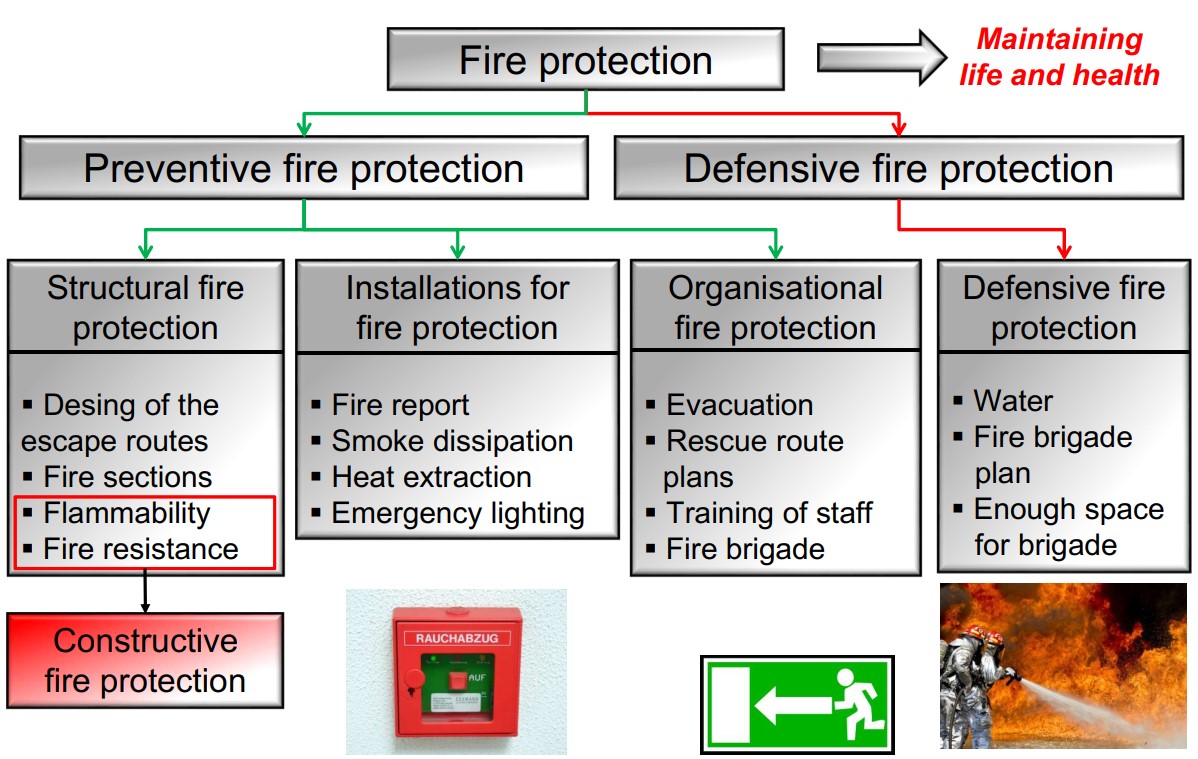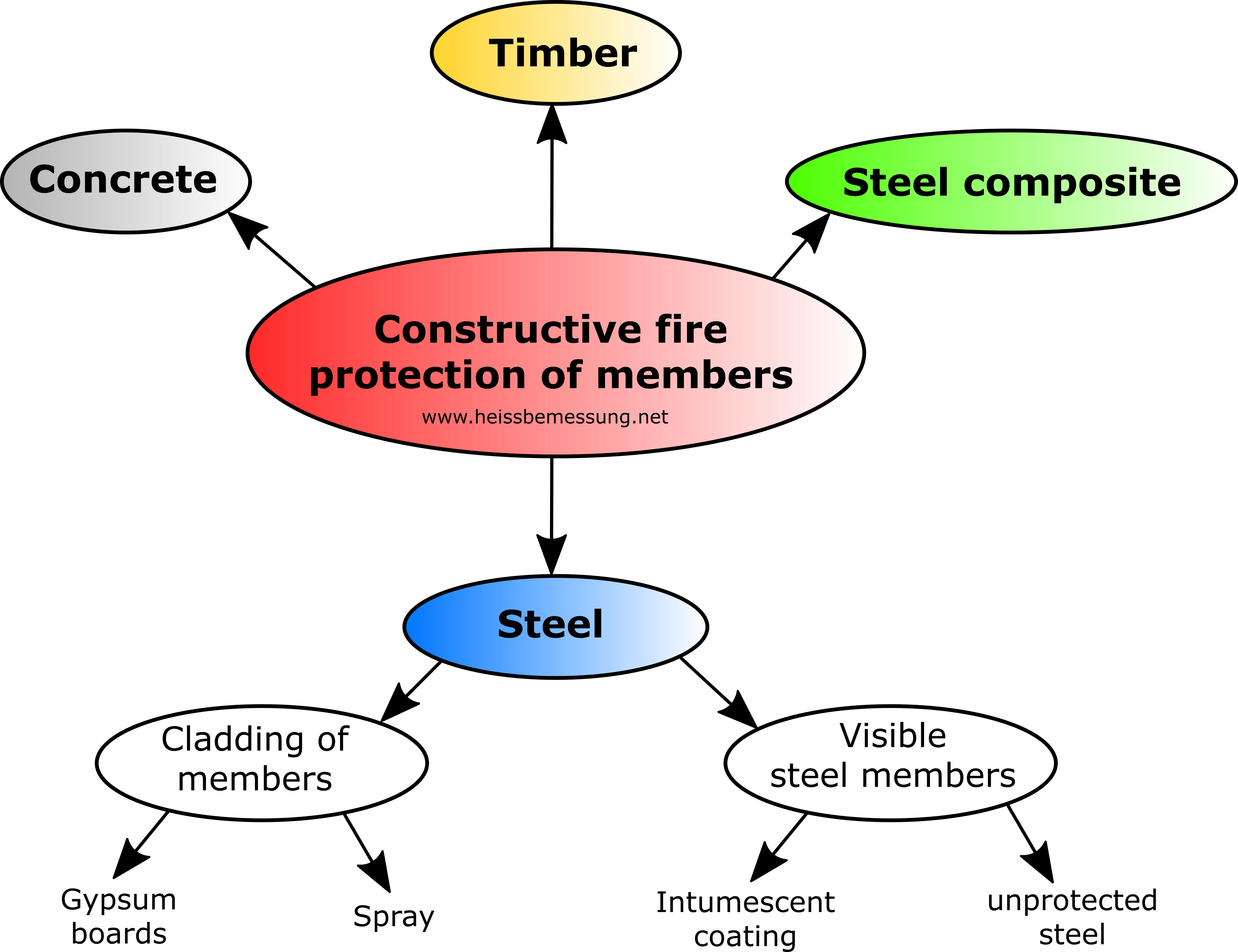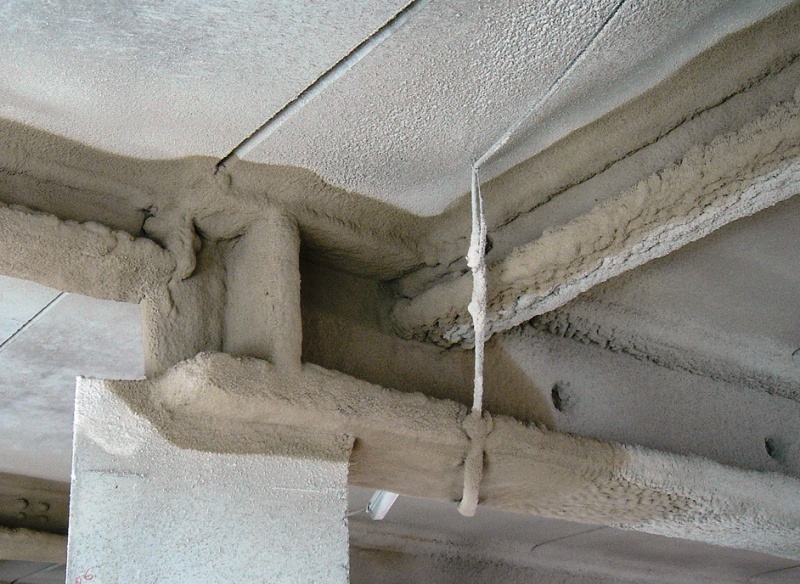Fire protection in building construction
What is fire protection?
The figure below allows a classification of the structural fire protection in the general fire protection. It can be seen in this that general fire protection pursues the preservation of life and health of humans and animals as the primary goal. In order to implement this goal, the preventive fire protection tries to prevent or limit a fire. In structural fire protection, e.g. fire compartments are such designed that a fire cannot spread unhindered in a building. To achieve that the fire compartments can withstand the high temperatures in the event of a fire, its components must meet certain requirements in terms of their flammability and fire resistance. These requirements represent the fire protection.

Selection of suitable materials to ensure structural fire protection
The structural fire protection of members can be achieved with different materials (see figure below). In Germany, reinforced concrete structures often dominate with regard to fire protection. You can find the reason for this in a exemplary comparison of the structural fire protection of reinforced concrete, steel and wood. The other construction methods of wood, steel and composite steel construction play a subordinate role, but this is changing in the course of the steady increase in engineering methods of fire protection (such as fire design). According to the relevant German standard DIN 4102-1, the fire behaviour of building materials and members is divided into the following five building material classes:
- Building material class A1: non-combustible and without combustible components (e.g. sand, reinforced concrete or steel);
- Building material class A2: non-flammable and to a lesser extent with flammable components (e.g. plasterboard);
- Building material class B1: flame retardant (e.g. lightweight panels out of wood wool);
- Building material class B2: normally flammable (e.g. wood);
- Building material class B3: easily inflammable (all materials that do not belong to classes A1 to B2).

Concrete structures
Concrete constructions achieve any fire resistance required in building construction without further structural fire protection measures. Concrete benefits e.g. compared to steel constructions because of its low thermal conductivity. It follows that concrete structures heat up slowly in the event of a fire and therefore lose their strength quite slowly.
Timber constructions
When exposed to fire, wood forms a pyrolysis layer that protects the wood from further heating. Timber structures play only a subordinate role in building construction and are therefore not considered further.
Steel composite structures
Due to the positive thermal properties of concrete, steel composite construction flourished in Germany in the 1990s in particular. In composite steel structures, steel and concrete are joined together in such a way that the surrounding concrete protects the steel from heating up too quickly. In addition, statically very powerful cross-sections are created, since the concrete is used in the compression area and the steel in the tension area. With composite steel structures, as with concrete structures, all the fire ratings required in building construction can be achieved. However, in Germany steel composite construction has mainly established itself in the construction of car parks and partly in high-rise construction. In other countries, steel composite construction is much more common, e.g. in UK and the USA.
Fire protection of steel components
Steel structures clad with spray plaster
Steel structures can be protected by spray plaster for fire resistance periods of up to approximately R180. In Germany, however, spray plaster is rarely used because the plaster cannot be applied very regularly and is therefore often perceived as unaesthetic.

Steel structures clad with plasterboard
Steel structures can be fireproofed through plasterboard for all required fire ratings. The disadvantage is the increased workload for assembling the plasterboard, which increases the construction costs.
Unprotected steel structures
Unprotected steel constructions do not achieve a fire rating with economic load utilization. There is, however, the possibility of taking into account so-called natural fires as part of a fire protection concept to include the actual fire loads. This can result in lower fire room temperatures in comparison to the ISO standard fire, so that the steel structure can possibly be made unprotected. The approval of the building authority is required for this procedure and there are additional costs for the fire protection report. Therefore, unprotected steel structures are not common in normal building construction. Industrial halls are an important exception. In the German so-called sample industrial building guidelines (MIndBauRl) it is regulated that the steel structure in industrial halls may be carried out unprotected if certain boundary conditions are met, such as the permissible fire compartment area.
Steel structures protected with intumescent coating
Steel structures can also be protected with a so-called intumescent coating up to a fire rating of R90. In the event of a fire, the intumescent coating expands and protects the underlying steel through the enclosed air pores from heating.
How we can help you
As a German engineering company, we can offer you a short-term fire design for your given task in the European Union or worldwide. The documentation contains the essential information on the heating of the cross-section, the fire resistance of the member or structure as well as its deformations. We can of course provide further services so do not hesitate to contact us.
What are your benefits?
Our clients often save costs by using sophisticated fire design. In the case of new buildings, leaner and therefore more economical constructions can be carried out. In the case of existing structures extensive upgrading measures can often be avoided by an accurate fire design.
Our initial consultation for your project
To clarify your specific task, it is best to call us. Or you can send us an e-mail with some key data. On this basis, we can discuss the framework conditions and create an attractive offer for you.